Texas is one of the states with large snake biodiversity. Some of the rarest snakes in the country are found here.
Texas is the home to 10 species of Rattlesnakes, and 3 subspecies of Copperheads. The warm Texas climate is home to rare US species such as the Mojave rattlesnake and the Desert massasauga.
Venomous and non-venomous snake species are the most common in Texas as follows.
Table of Contents
1. Western Ratsnake
Scientific name: Pantherophis obsoletus
Common name: Western rat snake, black rat snake, pilot black snake, simply black snake
Venomous: No

The Western Ratsnake is the most common snake species in Texas. It represents an agile non-venomous species.
Western Ratsnakes are known for their innate ability to climb trees. They can climb a tree on the tree trunk without the aid of branches. These snakes are also good swimmers.
The versatile nature of the snake is also seen in its habitats which range from rocky mountains to woodlands.
Western Ratsnakes have a varied diet, mainly comprised of vertebrates such as rats and young rabbits. They also eat frogs and various lizards.
Western Ratsnakes use constriction as a preying technique. They squeeze prey until their cardiovascular system is suppressed, killing the prey before eating it.
2. Western Diamond-backed Rattlesnake
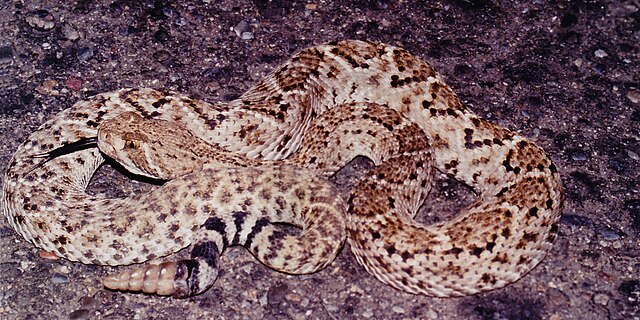
Scientific name: Crotalus atrox
Common name: Western diamond-back rattlesnake or Texas diamond-back
Venomous: Yes
One of the common snakes in Texas, the Western Diamon-backed Rattlesnake is responsible for most bites around the country.
This species is aggressive and venomous. Its venom attacks the circulatory system and it often prompts muscle catabolism, a process where certain proteins in the muscles are destroyed.
The snake has been shown to grow up to 5 feet in the wild and up to 7 feet in captivity.
Western Diamond-backed Rattlesnakes are known for feeding almost exclusively on mammals. This is a potent snake that hunts and night and maybe in the morning.
While common in the state, the Western Diamond-backed Rattlesnake might not be as easy to spot during the day. This gray and brown snake prefers to hide below shrubs and bushes during periods of inactivity.
3. Western Ribbon Snake

Scientific name: Thamnophis proximus
Common name: Western Ribbon Snake
Venomous: No
Part of the garter snake genus, the Western Ribbon Snake is identified by its small green body with yellow-white stripes.
The species is known for its reduced size as adults can measure up to 50 inches.
While shorter than other species, the Western Ribbon Snake is one of the species in Texas with specific preying techniques.
For example, it likes to thrust its head into a fake strike in multiple directions when planning to provoke frogs to exit their hiding spots. This makes frogs believe the snake’s attack.
Given its reduced size, the Western Ribbon Snake is also preyed upon by other species. Raptors and weasels are among their most common predators.
4. Plain-bellied Watersnake

Scientific name: Nerodia erythrogaster
Common name: Plain-bellied watersnake, plainbelly water snake
Venomous: No
This species is known for living next to water sources. As an aquatic species, the Plain-bellied Watersnake is known for traveling far away from water sources.
It gets its name from its light color belly which contrasts with its darker dorsal side.
Known for living in swamps and wet woodlands, this snake eats fish and amphibians all the time.
It’s highly likely to see this species around water sources during the summer. It’s best not to handle it as the Plan-bellied Watersnake is aggressive and it will bite given the chance, albeit without any venom.
5. Rough Earthsnake

Scientific name: Haldea striatula
Common name: Rough Earthsnake
Venomous: No
Rough Earthsnakes populate vast Southern Texas habitats. The snake is known for its slim short figure. It reaches up to 10 inches in adulthood.
The Rough Earthsnake is one of the most common snakes in Texas that have a docile temperament, even when handled.
These snakes have teeth but they don’t bite.
As its name suggests, the species is adapted for living underground. When it cannot find burrows and nests of other species it’s still found under piles of leaves, rocks, and ornamental stones in gardens.
6. Diamondback Watersnake

Scientific name: Nerodia rhombifer
Common name: Diamondback Watersnake
Venomous: No
The Diamondback Watersnake is known for its rough body due to its keeled scales. The species is adapted to living next to water sources.
Diamondback Waternskaes feed on multiple types of fish. Adaptations allow these snakes to dive their heads underwater looking for fish. Sharp teeth help them grab onto slippery fish efficiently.
These snakes can be seen during the day on vegetation overhanging various water surfaces. It tends to drop into the water to escape when seeing people.
The Diamondback Watersnake is highly aggressive towards people. It bites either when cornered or when roughly handled.
Since it has sharp teeth (adapted for catching slippery fish), this snake can inflict a painful bite. The acute pain of its bite mistakenly made some people believe the snake is venomous.
7. Dekay’s Brownsnake

Scientific name: Storeria dekayi
Common name: De Kay’s brownsnake, De Kay’s snake, simply the brown snake
Venomous: No
This small snake is not venomous. This snake has a common appearance for snakes in Texas as it has a brown-gray body. It also features a lighter brown-gray stripe on its ventral side.
Known for its small to medium body size, this type of snake has a diet based on slugs and snails. It also eats earthworms, particularly in high humidity habitats.
This species is also known to go for snails. Dekay’s Brownsnake can suck out snails from their shell easily.
Snakes of the species have a wide range of predators as well. Toads and predatory birds such as hawks eat the snake.
8. Northern Cottonmouth

Scientific name: Agkistrodon piscivorus
Common name: Northern Cottonmouth
Venomous: Yes
The Northern Cottonmouth is one of the most dangerous species of snake in Texas. The species is known for its painful venom which can sometimes be deadly.
While this species is known to bite, its bite isn’t always fatal. However, amputation cases following a bite are reported.
The Northern Cottonmouth is one of the snakes that has adapted well to living in the Gulf Coast barrier islands and the Southern US. It has adapted better than Cottonmouth snakes.
This is the reason why Northern Cottonmouth snakes can live both in fresh water and saltwater habitats.
Northern Cottonmouth snakes are both diurnal and nocturnal. They might not be seen easily during the day in some habitats as they prefer to rest in shaded spots.
These snakes feed on aquatic prey such as fish and frogs.
They also consume small turtles. Given the chance, these snakes also turn to cannibalism eating their young.
9. Coachwhip

Scientific name: Masticophis flagellum
Common name: Coachwhip, the whip snake
Venomous: No
Coachwhip snakes are often subject to legends such as chasing people. While these snakes don’t chase people, they represent one of the fastest snakes in Texas.
Coachwhip snakes are identified by their black body which turns tan gradually towards the tail.
These snakes have large round eyes and they use eyesight to look for prey around sandy terrains and next to water sources.
Lizards and amphibians are part of their preferred diet.
The snakes are almost impossible to see on open ground as they run away when seeing people.
While the species is terrestrial, it possesses very good climbing abilities. These abilities are used when trying to escape a certain threat or predator.
The snake is aggressive when cornered or captured biting without warning.
10. Checkered Garter Snake

Scientific name: Thamnophis marcianus
Common name: Checkered Garter Snake
Venomous: No
This green-white species is known to live in grasslands around the state.
The snake is of medium size growing up to 42 inches on average. Snakes of this species are known to always seek new types of food such as frogs and various snails.
However, the Checkered Garter Snake is also known to refuse to eat the same food repeatedly in a short period as it can go on without food for months.
Checkered Garter Snakes also possess self-defense mechanisms such as releasing a foul smell. It uses this foul smell to keep large predators away.
11. Rough Greensnake

Scientific name: Opheodrys aestivus
Common name: Rough Greensnake
Venomous: No
The Rough Greensnake is a slender species that grows up to 45 inches. This species is tied to grasslands and woodlands where its green coloring acts as camouflage.
The species is mostly diurnal and it can be frequently seen around Central Texas. It likes to move terrestrially and around the water looking for various prey such as snails.
Rough Greensnakes reproduce once or twice per year, depending on the weather in the fall.
Female snakes lay eggs. They do this in common nests where other females of their species lay eggs as well.
A nest can number up to 75 eggs when multiple females lay eggs inside.
These nests are typically in the ground below rocks or logs which protect the nest from invaders.
12. Gopher Snake

Scientific name: Pituophis catenifer
Common name: Pacific gopher snake, coast gopher snake, Western gopher snake, gopher snake
Venomous: No
The Gopher Snake is recognized by its gray-brown body which can sometimes differ in color. Its color depends on the dominant vegetation color in its habitat.
Most Gopher Snakes are diurnal. They venture out for food rarely at night.
Studies show that this species is highly solitary spending the most time in its den.
The sole exception to its solitary life is during the mating season. Gopher snakes are attracted to pheromones released by scents released by the female which prompt the beginning of the mating season.
Eggs are laid with a hatching period of up to 75 days.
Unlike Rough Greensnakes, Gopher snakes only mate once per year.
13. Eastern Copperhead

Scientific name: Agkistrodon contortrix
Common name: Eastern Copperhead
Venomous: Yes
The Eastern Copperhead is one of the best-researched venomous snakes also found in Texas. This snake has a potentially-fatal bite with venom.
Eastern Copperheads don’t use all of their venom if they bite, however. These snakes first bite without inserting venom or by inserting a small amount of venom.
Still, even a small amount of venom is painful to humans. Symptoms of the bite with venom include headaches and tingly fingers.
While not as venomous as Cottonmouth snakes, Eastern Copperhead bites with venoms are treated medically with antivenin.
Further Reading:
14. Banded Watersnake

Scientific name: Nerodia fasciata
Common name: Banded watersnake, Southern watersnake
Venomous: No
The Banded Watersnake is known for having multiple colors and a banded-colored body. These bands are wider in the central parts of the body.
Banded Watersnakes are aquatic creatures spending most of their lives near water.
They are both diurnal and nocturnal and easily spotted in regions of the state as it lacks to lay in the sun for warmth during the day.
Snakes of the species are known to bear live young. Up to 20 live young snakes are born of a female Banded Watersnake each year.
15. Broad-banded Copperhead

Scientific name: Agkistrodon laticinctus
Common name: Broad-banded copperhead, copperhead moccasin, copperhead snake, dry-land moccasin, highland moccasin, moccasin, rattlesnake pilot, red eye, Texas copperhead, and thunder snake
Venomous: Yes
The Broad-banded Copperhead snake is a brown and tan banded venomous species also found in Texas.
Snakes of this species are secretive and nocturnal. Rarely seen by people, they should not be directly approached as they’re highly venomous.
Its venom is not fatal but it causes a lot of pain. Broad-banded Copperhead snakes cause severe pain, necrosis, fever, and swelling in the area of the bite.
While there’s no specific antivenin made against Broad-banded Copperhead venom, people bitten by this snake should seek medical attention.
16. Great Plains Ratsnake

Scientific name: Pantherophis emoryi
Common name: Brown rat snake, chicken snake, Eastern spotted snake, Emory’s Coluber, Emory’s pilot snake, Emory’s racer, Emory’s snake, gray rat snake, mouse snake, prairie rat snake, spotted mouse snake, Texas rat snake, Western pilot snake, great plains ratsnake
Venomous: No
Great Plains Ratsnakes are common in grasslands. They live and look for food in tall grass where they find prey such as small snakes, frogs, and lizards.
Snakes of the species are also known for consuming a wide number of eggs of various species. On occasion, the Great Plains Ratsnake also easts bats, particularly in habitats with caves.
These snakes cause economic damage in human-populated areas and farmlands. They are known for eating whole chicken.
Great Plains Ratsnakes that live in agricultural fields make the most of the presence of rats and mice.
17. Texas Coralsnake

Scientific name: Micrurus tener
Common name: Texas Coralsnake
Venomous: Yes
Native to Texas, the Texas Coralsnake is a slender multicolored snake that’s mostly red-brown, yellow, and black.
This snake has an exclusive diet made up of other snake species, particularly smaller snakes. Earth snakes and other snakes adapted to digging are the primary species the Texas Coralsnake is interested in.
The species is known for having a toxic venom that attacks the nervous system.
Some deaths were reported following Texas Coralsnake bites. These have been deaths triggered by its venom that lead to conditions such as respiratory problems.
Antivenin has been created against the species eliminating death cases following its bite.
18. North American Racer

Scientific name: Coluber constrictor
Common name: Eastern racer, North American racer
Venomous: No
The black snake is known for its quick movements and the ability to catch fast-moving prey. It eats insects, frogs, and lizards.
North American Racers are adapted to agricultural fields, grassland, and suburban areas as they don’t shy away from people.
The North American Racer is a mostly black snake. It lives in multiple places but prefers open areas where it has a better sight over its prey.
19. Eastern Hognose Snake

Scientific name: Heterodon platirhinos
Common name: Eastern Hognose Snake
Venomous: No
The Eastern Hognose Snake grows up to 41 inches and it’s distinguished by its wide body.
Snakes of this species are known to be afraid of people even if they see them frequently. These snakes are seen crossing the road in the summer in many parts of Texas and other parts of the Eastern US.
The ability to mimic cobras is one of the traits the snake is known for. It expands the skin around its head mimicking an attack and trying to appear more threatening.
Eastern Hognose Snakes also poses the ability to play dead. These snakes are known to roll over and stay still with mouths open as the last line of defense against predators.
This fake act is maintained for up to a few minutes. Afterward, the snake gets back on its belly moving along with or without making hissing sounds.
20. Texas Blind Snake

Scientific name: Rena dulcis
Common name: Texas blind snake, the Texas slender blind snake, the Texas threadsnake
Venomous: No
These small snakes are found all around Texas. It lives a secretive life underground. Since the snake only surfaces after rain, it’s hard to establish its clear population numbers.
The snake is known to feed on several insects. Termites are among its favorite type of food.
People find Texas Blind Snakes when they make it out of the ground, particularly after the rain has stopped when the soil is humid.
This snake cannot bite people as it has a very small mouth. Furthermore, the snake cannot inflict any type of pain on humans.
It uses a tapping technique where it taps or pokes the hands or predators with its tail. This is believed to have no other effect than to try and scare potential predators away.
21. Eastern Patch-nosed Snake

Scientific name: Salvadora grahamiae
Common name: Eastern Patch-nosed Snake
Venomous: No
The Eastern Patch-nosed Snake gets its name from the large scale on the top of its snout. The snake is known for its dark olive-green coloring with cream-yellow stripes that run from head to tail.
Endemic to the US and Mexico, the species is known to prefer grasslands where its coloring acts to its advantage as camouflage.
The species spreads to multiple habitats South of the border in Mexico as well.
22. Long-nosed Snake

Scientific name: Rhinocheilus lecontei
Common name: Long-nosed Snake
Venomous: No
The Long-nosed Snake gets its name from its upward-facing snout. Most commonly, the tricolored body of the species makes some people confuse it with Coral snakes.
As Coral snakes, the Long-nosed Snake has a short slender body.
Common in deserts and grassland, the species is known for its ability to live underground.
The species is mostly nocturnal rarely venturing out for food or warmth during the day.
It feeds on various amphibians and juvenile snakes. But the most distinctive trait of the species is the ability to release blood from its cloaca to appear dead.
This is done together with releasing a foul smell.
23. Eastern Black-tailed Rattlesnake

Scientific name: Crotalus ornatus
Common name: Black-tailed rattlesnake, Eastern black-tailed eattlesnake
Venomous: Yes
The Eastern Black-tailed Rattlesnake is a small to medium-sized venomous rattlesnake-family species found in Texas.
It grows to a maximum length between 30 and 42 inches. Eastern Black-tailed Rattlesnakes can sometimes be difficult to identify as they come in different colors.
These snakes are seen in colors such as green, olive, or gray. The constant physical characteristic is the black tail tip which is seen all across its various colors.
Eastern Black-tailed Rattlesnakes are venomous and dangerous. Data shows its venom isn’t as dangerous as the venom of other venomous snakes in the US.
However, medical treatment is needed following its bite. While the snake is more docile than other venomous snakes in Texas, it can still bite.
A distinct trait of its venom is its large venom gland. This is due to its reduced hemotoxic nature compared to the venom of other species.
The species’ venom is treated medically with antivenin.
Snakes of this genus aren’t easy to spot due to their multicolored bodies which make them hard to distinguish as camouflage is one of its characteristics.
Eastern Black-tailed Rattlesnakes live long lives. They can survive up to 20 years.
24. Chihuahuan Nightsnake

Scientific name: Hypsiglena jani
Common name: Texas nightsnake, Chihuahuan nightsnake
Venomous: No
The Chihuahuan Nightsnake is also called the Texas night snake for its nocturnal nature. Texas Nightsnakes are short, mostly growing to 16 inches in the wild.
Snakes of this species are found in arid areas of Texas but they’re also found in high numbers in the Eastern part of Mexico.
The nocturnal snakes mostly feed on lizards. They’re identified by their dark grey body.
Common thorough the state, this species is known for mating in the spring. Snakes of the genus are oviparous, but they only lay up to 6 eggs at a time.
25. Speckled Kingsnake

Scientific name: Lampropeltis holbrooki
Common name: Speckled Kingsnake
Venomous: No
The Speckled Kingsnake is known for its preferences for wetlands. Adaptations of the species also allow it to live in woodlands.
Much of its preferences for these habitats are dictated by the availability of mammals to prey upon. Rodents and frogs are commonly consumed by the species, together with occasional small birds.
This black and white snake has a combination of specks. This combination also gives it the name of the Salt and pepper snake.
Speckled Kingsnakes are further identified by their midrange size. They grow to around 40 inches. The largest-ever Speckled Kingsnake was longer, measuring more than 70 inches.
The species is nonvenomous and it’s a common sight around the state due to its diurnal habits. It can be seen around large rocks or hiding in piles of leaves during the day.
26. Glossy Snake

Scientific name: Arizona elegans
Common name: Glossy snake, faded snake
Venomous: No
Glossy snakes are endemic to Southeast US. They get their name from their faded brown and tan coloring.
These snakes grow to around 50 inches. Coloring and sizing often make people confuse them with Gopher snakes. One of the easiest ways to differentiate similar species is by taking the faded color of the Glossy snake into account.
Glossy snakes aren’t seen as frequently as Speckled Kingsnakes around Texas, mainly due to their nocturnal habits.
Most Glossy snakes aren’t very active during the day as they prefer to catch lizards at night.
The species is known to lay eggs. Offspring come out at a length of almost 10 inches.
27. Black-necked Gartersnake

Scientific name: Thamnophis cyrtopsis
Common name: Black-necked Gartersnake
Venomous: No
Growing to a size of around 40 inches, this snake is easy to recognize due to its yellow-orange stripe that runs along its body.
Snakes of the Black-necked Gartersnake species are seen around water sources in arid habitats.
The species feed on fish and other types of prey that live next to water sources.
It dives underwater looking for small fish that it eats directly by swallowing.
Black-necked Gartersnakes are frequently seen around water sources. The species is diurnal.
Hibernation is specific for these snakes that live up to a few years. They enter hibernation in the fall, next to the water sources they use for food in the spring and summer.
28. Flat-headed Snake
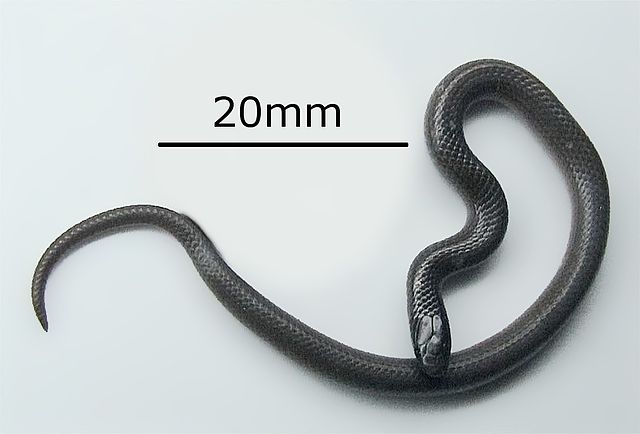
Scientific name: Tantilla gracilis
Common name: Flat-headed snake, flathead snake
Venomous: No
The Flat-headed Snake gets its name from its narrow head shape. It’s one of the most common species in parks and gardens around Texas.
Snakes of the species aren’t dangerous. They aren’t venomous and they don’t bite. People handle these snakes all the time.
Flat-headed Snakes are deep burrowers. It looks for moist ground in the summer which means it needs to go deep underground.
This species is still common in Texas but it’s facing a diminishing habitat and even a threatened status in other states such as Illinois.
29. Mojave Rattlesnake

Scientific name: Crotalus scutulatus
Common name: Mojave rattlesnake, Mojave green
Venomous: Yes
This common species lives in deserts. It’s one of the most dangerous venomous snakes living in Texas.
Mojave Rattlesnakes have a known desert habitat across multiple US states and Mexico.
This snake lives at various altitudes and it’s one of the most venomous snakes in the US and the most venomous Rattlesnake in the country.
The species is recognized by its faded gray or faded green coloring.
It should be avoided as its venom attacks both the tissues it has bitten such as muscles as well as the nervous system.
Survival chances are high, but only with medical attention.
One of the biggest causes of concern with its potent venom is not taking it seriously as symptoms may appear later.
Immediate symptoms following a bite include blurred vision. An antivenin is among the medical treatments recommended against its potent venom.
30. Trans-pecos Ratsnake
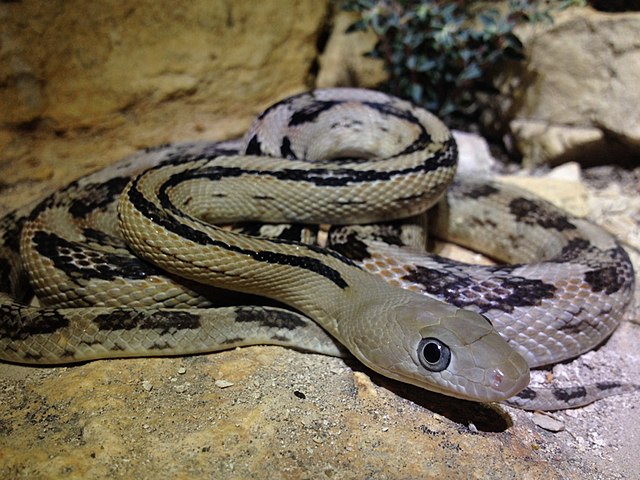
Scientific name: Bogertophis subocularis
Common name: Trans-pecos ratsnake, Davis Mountain ratsnake
Venomous: No
Known for living around the Chihuahuan Desert, this species is recognized for its distinct coloring. It has a yellow body with brown H-like markings.
The species is known to be dimorphic which means females are larger than males.
Both females and males grow up to a length of 54 inches.
Snakes of this genus are known to feed on desert vertebrates.
Trans-pecos Ratsnakes prefer rodents. However, they haven’t seen hunting or moving around during the day as they only come out at night.
31. Ground Snake
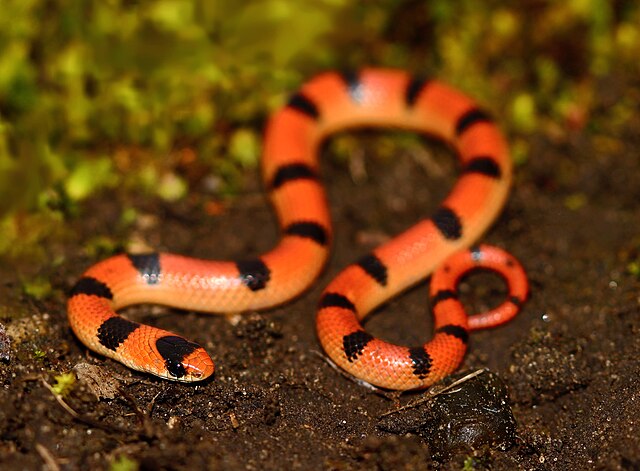
Scientific name: Sonora semiannulata
Common name: Ground snake, Western ground snake, variable ground snake
Venomous: No
Ground snakes are common around Texas. They are identified by a mostly orange body with black banding.
Snakes of the genus only come out at night. They prefer humid habitats such as grassland and shaded areas in rocky habitats.
Ground snakes are mostly seen on loose soil patches at high altitudes.
As nocturnal species, interactions with humans are minimum.
These snakes only come out at night when they’re seeking food. Reduced body size also means they’re prey is small. Most Ground snakes eat insects and spiders.
Scorpions are also among their favorite foods as they can share the same habitat.
32. Central American Indigo Snake

Scientific name: Drymarchon melanurus
Common name: Middle American indigo snake, blacktail cribo, central American indigo snake
Venomous: No
The Central American Indigo species is one of the largest in Texas. This snake doesn’t have an indigo color as it’s mostly olive-green with a yellow underside.
Central American Indigo snakes are found across Southern parts of Texas. Most members of the species live on the East Coast of Mexico.
Males and females of the Central American Indigo species grow to at least 6 feet. They can sometimes grow to more than 8 feet.
While large, the species isn’t venomous.
33. Timber Rattlesnake

Scientific name: Crotalus horridus
Common name: Timber rattlesnake, canebrake rattlesnake, banded rattlesnake
Venomous: Yes
Timber Rattlesnakes are among the most venomous snakes in the US. While not deadly if medical care is attributed following a bite, its venom is still highly dangerous.
These snakes have some of the longest fangs of all Rattlesnakes. Their venom is known to attack the nervous system. General Rattlesnake antivenin is given to those seeking medical treatment often.
Recorded deaths following its bite are rare. Still, this snake is not as common in Texas as it’s known to live in higher numbers around Northeastern parts of the country.
Its preferred habitat is South of Ontario.
In Texas, the species likes rugged terrains. Only females are seen during the day as they come out to bask in the sun.
34. Ring-necked Snake

Scientific name: Diadophis punctatus
Common name: Ring-necked snake, ringneck snake
Venomous: No
Ring-necked snakes are known for their dark green-olive color and bright yellow ring that goes around the neck.
The underside of this snake is also bright yellow. Ring-necked snakes show their bright-color underside by curling up their tails in a defensive position.
Ring-necked snakes are smaller than the average Texas species. They can be as short as 10 inches with the largest individuals measuring 15 inches.
Slugs and salamanders are among the favorite species these snakes eat.
35. Prairie Rattlesnake

Scientific name: Crotalus viridis
Common name: Prairie rattlesnake, great plains rattlesnake
Venomous: Yes
The Prairie Rattlesnake is one of the venomous Rattlesnakes found in Texas. Its venom affects both the tissue of the bite and the central nervous system of its prey.
These snakes are identified by their colored bodies which are mostly seen in shades of gray and brown.
The Prairie Rattlesnake has a wide habitat and a variable diet. It lives on the ground but it can also climb trees for birds and squirrels.
Venomous snakes of the species don’t lay eggs. They are known for carrying live young. Up to 25 live young snakes are produced in the mating season by the female snake.
36. Prairie Kingsnake

Scientific name: Lampropeltis calligaster
Common name: Prairie kingsnake, yellow-bellied kingsnake
Venomous: No
This family of snakes is known for living next to forests in grasslands. Its preferred habitat has to be close to the water as this is where it finds most of its prey around.
This snake can be dark gray. It also appears to be dark brown. At times, it’s seen with white spots on its body, believed to be a defensive mechanism when under threat.
Prairie Kingsnakes aren’t venomous. These snakes are known for having a docile temper and they can be handled without biting.
Prairie Kingsnakes are known to be among the multiple species in Texas that can release a foul smell. This smell is released when facing a threat.
Snakes of the genus always release this foul smell when touched.
37. Rock Rattlesnake

Scientific name: Crotalus lepidus
Common name: Blue rattlesnake, Eastern rock rattlesnake, green rattlesnake, little green rattlesnake, pink rattlesnake, rock rattlesnake, Texas rock rattlesnake, and white rattlesnake
Venomous: Yes
The Rock Rattlesnake is also known as the Eastern Rock Rattlesnake. It gets its name for its preference for living in rocky areas. Its pale gray coloring favors its camouflage in these areas.
While nocturnal, the snake is still seen around Texas, particularly on roads that pass through rocky terrains. It comes out on warm roads at night.
The snake is also venomous. While its venom is potent and requires medication, the species is not considered as threatening as other Rattlesnakes.
It doesn’t use its venom frequently. In most cases when this snake bites and inserts venom is when touched, scared, or aggressed.
38. Desert Kingsnake

Scientific name: Lampropeltis splendida
Common name: Desert Kingsnake
Venomous: No
This species of nonvenomous snake is known for its large body. It grows up to 4 feet in Texas but can reach up to 8 feet in captivity.
The Desert Kingsnake is often associated with deserts given its name. However, it prefers to live in the vegetation around water sources such as lakes and rivers.
Desert Kingsnakes are known to eat a wide range of mammals and even other snakes. These snakes are even known to eat venomous snakes as they resist their bites and venom.
Young Diamondback Rattlesnakes are often eaten by the Desert Kingsnake.
This snake is also found in rural areas that are close to water sources. Some people even used it to control the species of other snakes on farms.
39. Western Massasauga

Scientific name: Sistrurus tergeminus
Common name: Western massasauga, ground rattlesnake, Gulf Coast massasauga, Edward’s massasauga, large ground rattlesnake, Say’s false rattlesnake, Sonora ground rattlesnake, Texas massasauga, three-spotted shield rattler, triple-spotted rattlesnake
Venomous: Yes
Known for its tan-gray marks, this snake is common around Texas grasslands.
The Western Massasauga is one of the most venomous types of snakes in the state. It’s not perceived as the most dangerous species because it inserts less venom compared to Rattlesnakes.
However, its venom is considerably more toxic than the venom of Rattlesnake.
These nocturnal snakes can still bite. Their venom causes necrosis and it requires medical attention.
40. Mississippi Green Watersnake

Scientific name: Nerodia cyclopion
Common name: Mississippi green watersnake , green watersnake
Venomous: No
Snakes of the Mississippi Green Watersnake genus have a distinct dark green color. This is an adaptation to living in vegetation next to water sources.
The snakes constrict their prey. Fish and various amphibians are among their recommended prey.
Known for their dark-colored bodies, these snakes come in various sizes ranging from 30 to 55 inches.
They prefer to flee when meeting people. However, if, cornered, these snakes become very aggressive.
While not venomous, the Mississippi Green Watersnake repeatedly bites people and animals whenever cornered.
41. Striped Whipsnake
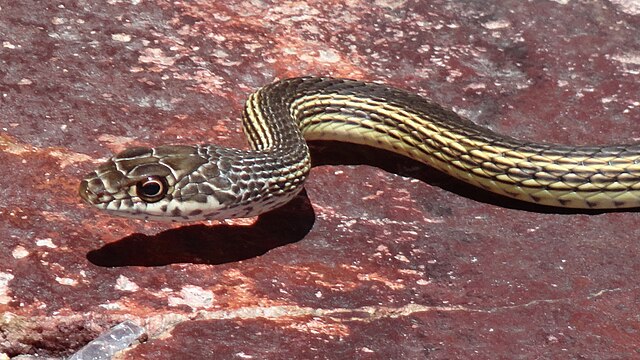
Scientific name: Masticophis taeniatus
Common name: Striped Whipsnake
Venomous: No
The dark-brown Striped Whipsnake grows to a size of over 70 inches. It’s one of the large species found in Texas grasslands and shrublands.
These snakes are known to lay multiple eggs at a time during the spring. They emerge as potential predators that eat mammals and even other venomous snakes.
Striped Whipsnakes are a common sight in parts of Texas. This snake is diurnal.
While known as one of the fastest snakes in the state, its daytime hunting activities make it a common sight in areas with dense vegetation.
42. Baird’s Ratsnake
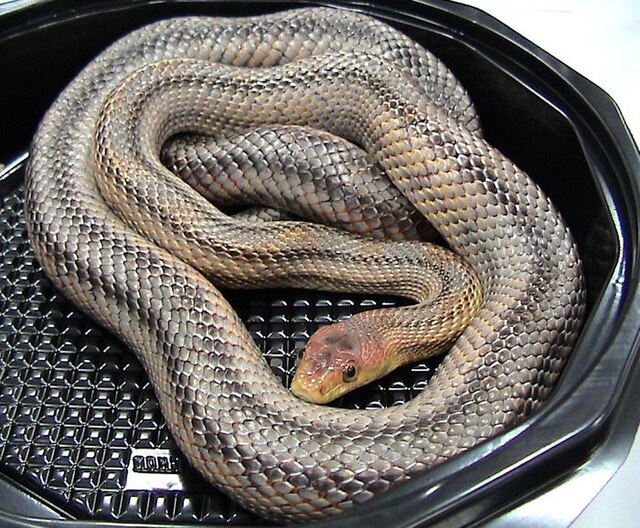
Scientific name: Pantherophis bairdi
Common name: Baird’s rat snake, Baird’s ratsnake, Baird’s pilot snake, Baird’s Coluber, Great Bend rat snake
Venomous: No
This species of multicolored snake lives in arid terrains and rocky habitats in Texas and neighboring states.
As adults, they largely feed on rodents. Juveniles are known for eating other animals such as lizards.
These snakes are known for their orange and yellow marks on their dark body which makes them easy to spot.
They can reach a length of up to 55 inches.
A common sight in Texas and Mexico, these snakes can sometimes be handled as they have a more docile nature compared to other Ratsnakes.
43. Saltmarsh Snake

Scientific name: Nerodia clarkii
Common name: Saltmarsh Snake
Venomous: No
These snakes are known to prefer saltwater habitats and areas near saltwater.
They may be difficult to identify as they come in multiple colors with or without stripes. Snakes of this genus can be green, gray, or brown, with or without bright color stripes that run from the head to the tail.
While common in Texas, people rarely get to see these snakes due to their remote habitats.
They are generally not aggressive preferring to flee when seeing humans.
Saltmarsh snakes are also nocturnal. They prefer to come out at night looking for food such as fish.
44. Lined Snake

Scientific name: Tropidoclonion lineatum
Common name: Dwarf garter snake, grass snake, lined snake, ribbon snake, streaked snake, striped snake, and swamp snake
Venomous: No
Living in grasslands, the Lined snake is known for its dark green body with bright yellow lines that run from head to tail.
Its name inspires the bright lines that make it stand out and not a specie known for its camouflage appearance.
They are often seen outside grassland habitats, particularly in soft soil habitats.
The preference for soft soils is influenced by the almost burrowing nature of these snakes. While not specifically interested in living underground, these snakes prefer to live under rocks, vegetation, and logs.
45. Schott’s Whipsnake

Scientific name: Masticophis schotti
Common name: Schott’s Whipsnake
Venomous: No
Snakes of this species are known to live in desert and arid climates around the state. While both diurnal and nocturnal, they prefer to hide in rodent burrows in the afternoon to escape high heat.
They can be recognized by a gray color with blue or green nuances and 2 lines that run from head down the body.
Since they like to live in the burrows of various mammals, these snakes are also known to capture and eat these mammals in their burrows.
Rodents such as rats and Southern plains woodrats are among its preferred prey.
Further Reading: